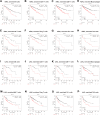Prognostic Value of Long Noncoding RNA DLEU2 and Its Relationship with Immune Infiltration in Kidney Renal Clear Cell Carcinoma and Liver Hepatocellular Carcinoma
- PMID: 34795513
- PMCID: PMC8593347
- DOI: 10.2147/IJGM.S336428
Prognostic Value of Long Noncoding RNA DLEU2 and Its Relationship with Immune Infiltration in Kidney Renal Clear Cell Carcinoma and Liver Hepatocellular Carcinoma
Abstract
Background: DLEU2 is a long noncoding RNA considered important in the progression of many cancers. However, correlations between DLEU2 and kidney renal clear cell carcinoma (KIRC) and liver hepatocellular carcinoma (LIHC) have rarely been reported.
Methods: We first analysed the expression of DLEU2 across cancers and the correlation between DLEU2 and the clinical features of KIRC and LIHC by using the "ggplot2" package in R and searched the Oncomine database and Timer website platform. We verified the expression of DLEU2 in the GEO dataset (GSE105261 and GSE45267). Receiver operating characteristic (ROC) curves were drawn using the "pROC" and "ggplot2" packages in R, and we constructed a DLEU2-based prognostic nomogram for KIRC and LIHC by using the "survival" and "rms" packages in R. Then, we analysed the correlation between DLEU2 expression and prognosis in R as well as the correlation between DLEU2 and immune cell infiltration in the TIMER database. Finally, we explored the causes of DLEU2 upregulation in the UCSC Xena and UALCAN databases.
Results: We found that DLEU2 was upregulated in many cancers, including KIRC and LIHC. Expression of DLEU2 is associated with tumour stage, grade, lymphatic metastasis, and distant metastasis in KIRC as well as alpha-fetoprotein (AFP), tumour stage, grade, lymphatic metastasis, and distant metastasis in LIHC. DLEU2 is an adverse factor for the prognosis of KIRC and LIHC. In addition, DLEU2 has moderate accuracy in diagnosing KIRC and LIHC and predicting their prognosis. Moreover, we found that expression of DLEU2 correlated positively with immune cell infiltration in KIRC and LIHC, and upregulation of DLEU2 in KIRC and LIHC suggests a poor prognosis based on immune cells analysis. Genetic and epigenetic analyses of DLEU2 indicate that copy number variations (CNVs) and methylation contribute to the upregulation of DLEU2.
Conclusion: The long noncoding RNA DLEU2 has the potential to predict the prognosis and immune infiltration of KIRC and LIHC.
Keywords: DLEU2; KIRC; LIHC; immune infiltration; prognosis.
© 2021 Fu et al.
Conflict of interest statement
The authors have no conflicts of interest or competing financial interests in this study to declare.
Figures








Similar articles
-
ASPM Is a Prognostic Biomarker and Correlates With Immune Infiltration in Kidney Renal Clear Cell Carcinoma and Liver Hepatocellular Carcinoma.Front Oncol. 2022 Apr 20;12:632042. doi: 10.3389/fonc.2022.632042. eCollection 2022. Front Oncol. 2022. PMID: 35515103 Free PMC article.
-
The Multifaceted Role of lncRNA GAS5: A Pan-Cancer Analysis of Its Diagnostic, Prognostic, and Therapeutic Potential.Cureus. 2025 Jan 16;17(1):e77527. doi: 10.7759/cureus.77527. eCollection 2025 Jan. Cureus. 2025. PMID: 39958058 Free PMC article.
-
Gain of GAS5 reveals worse prognosis in kidney renal clear cell carcinoma and liver hepatocellular carcinoma from the Cancer Genome Atlas dataset.Transl Cancer Res. 2021 Jan;10(1):223-232. doi: 10.21037/tcr-20-2221. Transl Cancer Res. 2021. PMID: 35116254 Free PMC article.
-
CTHRC1 Is a Prognostic Biomarker and Correlated With Immune Infiltrates in Kidney Renal Papillary Cell Carcinoma and Kidney Renal Clear Cell Carcinoma.Front Oncol. 2021 Feb 8;10:570819. doi: 10.3389/fonc.2020.570819. eCollection 2020. Front Oncol. 2021. PMID: 33628726 Free PMC article.
-
Identification of ASF1B as a prognostic marker for liver cancer by meta-analysis and its immune value revealed by a comprehensive pan-cancer analysis of 33 human cancers.Prz Gastroenterol. 2023;18(3):249-265. doi: 10.5114/pg.2023.124423. Epub 2023 Jan 23. Prz Gastroenterol. 2023. PMID: 37937108 Free PMC article. Review.
Cited by
-
Established and emerging biomarkers of immunotherapy in renal cell carcinoma.Immunotherapy. 2024 Apr;16(6):405-426. doi: 10.2217/imt-2023-0267. Epub 2024 Jan 24. Immunotherapy. 2024. PMID: 38264827 Free PMC article. Review.
-
The Role of Long Noncoding RNA (lncRNAs) Biomarkers in Renal Cell Carcinoma.Int J Mol Sci. 2022 Dec 30;24(1):643. doi: 10.3390/ijms24010643. Int J Mol Sci. 2022. PMID: 36614082 Free PMC article. Review.
-
Ogt Demonstrated Conspicuous Clinical Significance in Cancers, from Pan-Cancer to Small-Cell Lung Cancer.J Oncol. 2022 Mar 21;2022:2010341. doi: 10.1155/2022/2010341. eCollection 2022. J Oncol. 2022. PMID: 35356257 Free PMC article.
-
Identification of key biomarker genes in liver hepatocellular carcinoma and kidney renal clear cell carcinoma progression: A shared high-throughput screening and molecular docking method with potentials for targeted therapeutic interventions.J Genet Eng Biotechnol. 2025 Jun;23(2):100497. doi: 10.1016/j.jgeb.2025.100497. Epub 2025 Apr 22. J Genet Eng Biotechnol. 2025. PMID: 40390492 Free PMC article.
References
LinkOut - more resources
Full Text Sources

